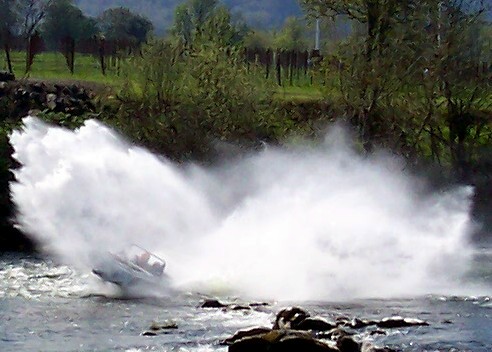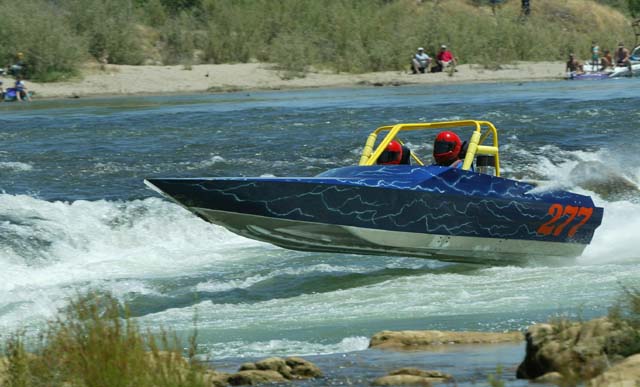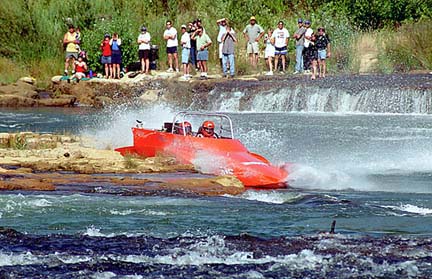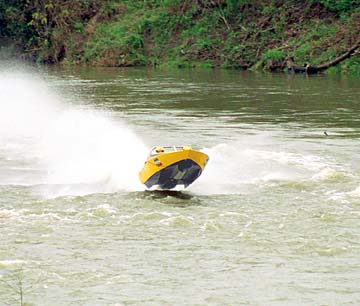of which makes it an interesting spectacle to observe and compete in!

Racing
The basic idea is to take a boat powered by an automobile engine and
a jet pump and race it on a river from point A to point B, wait for
everyone
to make it, then race from
point B back to point A. You are competing for
total time for the weekend AND points per leg. The three lowest times
in
each class for the weekend are awarded
trophies and cash. Everyone also
accumulates points per leg by time, and these go towards your standing
in the local Country Championship.
Starts
On most rivers, there is not enough room to safely race two boats side
by side so we use staggered start times, generally one minute apart.
You
will see a white flag go up
ten seconds before each start time and then
a green flag ON each start time. You cannot cross the start line BEFORE
the green flag goes up (significant penalty) but
you can, if you are good
at it, charge the start line and ideally cross it at a high percentage
of your top speed just as the green flag goes up. Boats are put in
the
start order by their estimated speed compared to the other boats,
fastest
boats first.
From the start you carry on to the finish line as fast as you can
make
it. This generally involves aerobatics, close calls and dumb boat
tricks
all
of which makes it an interesting spectacle to observe and compete in!

Sweep Boat
The sweep boat runs last, is usually a family type boat and usually
has rescue people aboard. It's function is to sweep the course. It is
also
carrying race
officials and the starter/scorers.
DNF / DNS
If you start a leg but break down and the sweep boat passes you, the
leg is over for you and you are awarded a Did Not Finish (DNF) time
which
is calculated
from the slowest finishing boats time for your class plus
a calculated percentage of the slowest time. DNS: A Did Not Start (DNS)
is a penalty for not making
a start at all, usually what happens on the
next and subsequent legs if you are sitting on the bank, broke down. It
carries an even stiffer time penalty than a
DNF. Lots of motivation there
to get it running again and catch the next leg if possible.
If you can get it running, you ARE allowed to motor to the next
start
AFTER the sweep boat has passed and a set time before the next
set
of starts. At some
races this rule is modified and you end up on the bank
at least until a lunch break if you break down. This is done when it is
a series of short turn arounds
and is done for safety.
Time between legs
The next legs start time is set ahead of time and is determined by
an estimate of how long it's going to take everyone to complete the
course
and for the
sweep boat to cover the course looking for broken boats and
making sure that anybody that needs help gets it.
Usually on a short course the leg start times will be a minimum of
45 minutes apart. On long courses and with lots of boats they go an
hour
or more between
start times. If all this starting, stopping and scoring
sounds like a lot of stuff to coordinate, it is and usually takes a
dedicated
team of 4 or 5 people and a
couple of boats to accomplish. All the boats
are carrying a clock that is synched to the official race time, to the
second, for use in getting to the line at the right time.
Boat Classes
We have several classes of boats, each competing for their own set
of
trophies, prizes and times. This is done to allow folks to compete at
there
own comfort
level, money and speedwise. The common rules are that they
all have to be motivated by a jet pump and all the safety rules apply.
Unlimited Class, numbers 300 to 399
Any hull, minimum 16 feet in length.
Any motor or motors, of any type of any displacement.
This means 640 cubic inch motors, helicopter engines
or 52 Wankels
bolted together if that's what you think would do the job.
speeds over 135 mph
A-class, numbers 200-299 or lower with the letter A affixed.
Any hull, minimum length 16 feet.
displacement 367 to 470 cubic inches, naturally aspirated.
These boats are capable of 120 mph.
B-class, numbers 100-199 or affixed with the letter B.
Any hull, minimum length 16 feet.
displacement 310 to 366 cubic inches, naturally aspirated.
These boats are capable of 110 mph.
CX, numbers 100-199
Any hull, minimum length 16 feet.
Chevy LS3 CT525 crate motor 525 hp, Dodge and Ford equivalents
Very limited modifications, none for performance.
speeds around 100 mph
SBFX, numbers 0-50
Any hull, minimum length 14 feet.
350 Chevy ZZ4 crate motor Dodge and Ford equivalents
Very limited modifications, none for performance.
speeds around 90 mph
SBFXV, numbers
0-50
V and Step-tech hulls, minimum
length 14 feet.
350 Chevy ZZ4 crate motor Dodge and
Ford equivalents
Very limited modifications, none for
performance.
speeds around 80 mph
The Boats
Engines range from exotic (Turboshaft, Nascar heads, dry sumps,
sheet metal intakes,
etc.) to extremely ordinary (ZZ4 crate engine). The single attribute
they
all have to have is longevity
as they typically spend 95 percent of any
leg at full load and full throttle. That is very similiar to a dyno
pull
if dyno pulls lasted 30 minutes at a time. Most cooling systems are
simply
river water
at around 15 psi routed through the engine and then overboard,
temperature controlled by flow which is controlled by a ball valve.
Most,
but not all, boats run alternators.
The boats themselves are fairly simple, a driveline from the engine
spins the pump. Steering is via a steering wheel moving a cable
that
looks like a giant throttle cable. It ultimately controls
which direction,
left or right, that the water stream leaves the nozzle which of course
controls the direction of the boat. The underside of the boats are
pretty
much smooth, not very much
hanging down as whatever there is gets
to the rocks first. The driver has two controls, steering and throttle.
No brakes, no clutch, no shifter. Sort of the ultimate expression of
stab
it and steer it.
Safety equipment is different from most types of boat racing in that
roll bars are required as are full racing harnesses. The rollbars are
useless
in deep water, but they are absolute lifesavers if
you roll over onto a
gravel bar or into shallow water. This has happened, the most recent
occurence
known as the Hoopa Guacomole Episode. Crews wear helmets, fire suits
and
specialized racing lifejackets. Some typical marine good sense rules
are
applied also, such as venting fuel tanks overboard and the carrying of
two fire extinguishers.
Most of the real wizardry in these boats is in the pumps,
intakes
and hulls. The great strides in speed that has happened in the last 10
or
15 years is mostly from advances in the hulls and
pumps. All the boats are
aluminum, with sometimes a high abrasive steel bottom added, but the
rules
do allow construction from other materials.
From the driver's seat
A crew of two
Each boat crew has a driver and a navigator.
The driver is the primary set of eyes and, in theory, has the whole
course
fixed in his mind. They can read the river and adjust for
changing conditions and compensate for problems with the boat.
They are responsible for getting the most out of the
boat and the course. The navigator is the second set of
eyes, and also
has the course memorized. The navigator also watchs engine gauges
and may
be in charge of controls other than the steering and throttle such as
the
valve for
controlling engine temperature or mixture on fuel injection systems.
The navigator is also usually the primary for watching for
overtaking boats.
The navigator also keeps the time
for starting and for red or yellow flag
delays. Depending on who you talk to and what kind of run they just
had, the driver's job is to do their level best to scare the
Navigator and themselves silly by driving like
an idiot, the navigators job is to do everything else.
Duties and jobs are different in each crew, these are general duties.
It's very loud. Most of it is the motor howling right behind
you. The wind rushing
past and through your helmet contributes as does the squall of the
pump and the
water sliding by the aluminum hull. Most drivers wear earplugs.
Seeing is everything. Different sun angles, overcast and wind
blowing on the water
all affect how the track (the river) looks. It is utmostly important
to be able to read
the water, sometimes its easier than other times. Sometimes it's
impossible
and you
are relying totally on memory. Then there is the classic debate of
whether it's easier going
upriver or down. The look of a riffle or rock changes completely
depending
on if
you are going up through it or down through it. A rock you can plainly
see going
up river might be totally invisible going down river. Ideally, you
would be good at reading the water in both directions.

There are multiple fast lines through each corner and riffle. Some
are
faster than others
of course, but to the 'fast' attribute you can add or subtract:
smoothness,
danger-close
obstacles (because these boats move around from were you point them
quite a bit), rollers
that may launch you or send you off sideways. As in road sports, the
best line is the fastest
one that sets you up for the next corner, riffle or obstacle. Unlike
most road sports, sometimes
you can gamble that you can miss obstacles so that you may take
advantage
of a really fast line.
To do this, you need to know the river of course. (AND remember it
correctly)

The boat hits HARD sometimes. But you get used to it. Makes
you think quite a bit about
things like motor mounts, stringers and pump intakes. Hitting water
is usually rougher than hitting
objects, depends on how you hit the object.
Getting air is fairly normal. How much depends on what you
just
jumped and how fast you were going.
Sometimes it's the best way through. Jumping once is better (faster)
than plowing through three rollers, kind of like motocross.

If you have run hard enough and you have good sense, your knees might
be banging together at the top end. It is a decent indicator
of how hard you pushed yourself.